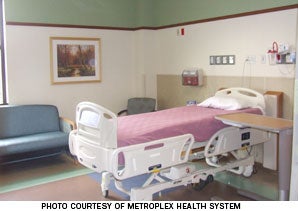Hospitals expand progressive care units for 'extra level' of attention
 In April 2011, a new 16,000-square-foot, 24-bed facility opened at Metroplex Adventist Hospital in Killeen, Texas. It's a progressive care unit designed for patients who are too sick for a general floor, but not critically ill enough for intensive care. Many have cardiac conditions and require telemetry monitoring.
In April 2011, a new 16,000-square-foot, 24-bed facility opened at Metroplex Adventist Hospital in Killeen, Texas. It's a progressive care unit designed for patients who are too sick for a general floor, but not critically ill enough for intensive care. Many have cardiac conditions and require telemetry monitoring.
"There are more and more patients who need that extra level of care that you don't get on a traditional medical-surgical unit," Ginger Henderson, R.N., vice president and chief nursing officer at Metroplex Health System, tells Health Facilities Management's sister publication, Hospitals & Health Networks. The hospital's previous step-down or intermediate unit of 14 beds was too small to accommodate the growing demand. "We were constantly full."
As hospitals expand or open progressive care units, they should take into account their patient volumes and acuity, adjusting staff resources, space and technology to meet those needs while adhering to reimbursement guidelines.
"It helps with capacity management," says Patti A. Wengert, R.N., director of heart and vascular nursing at Penn State Hershey (Pa.) Medical Center. As a result, the hospital is able to accept a higher number of critically ill and sicker patients. "It allows us to flex the number of nursing staff who are working on any shift based on the acuity and workload."
Care in these units — also called telemetry, step-down or intermediate care — often is guided by a clinical pathway based on the patient's status at admission time. For instance, this care map outlines the progress that someone recovering from a heart attack should make on each subsequent day, says Kenneth J. Rempher, R.N., assistant vice president of patient care services at Sinai Hospital of Baltimore.
Mary Stahl, R.N., a clinical nurse specialist in medical cardiology at Saint Luke's Hospital in Kansas City, Mo., and president of the American Association of Critical-Care Nurses, says patients in these units may need a higher level of interaction from other care providers, such as physical and occupational therapists, dietitians and social workers.




